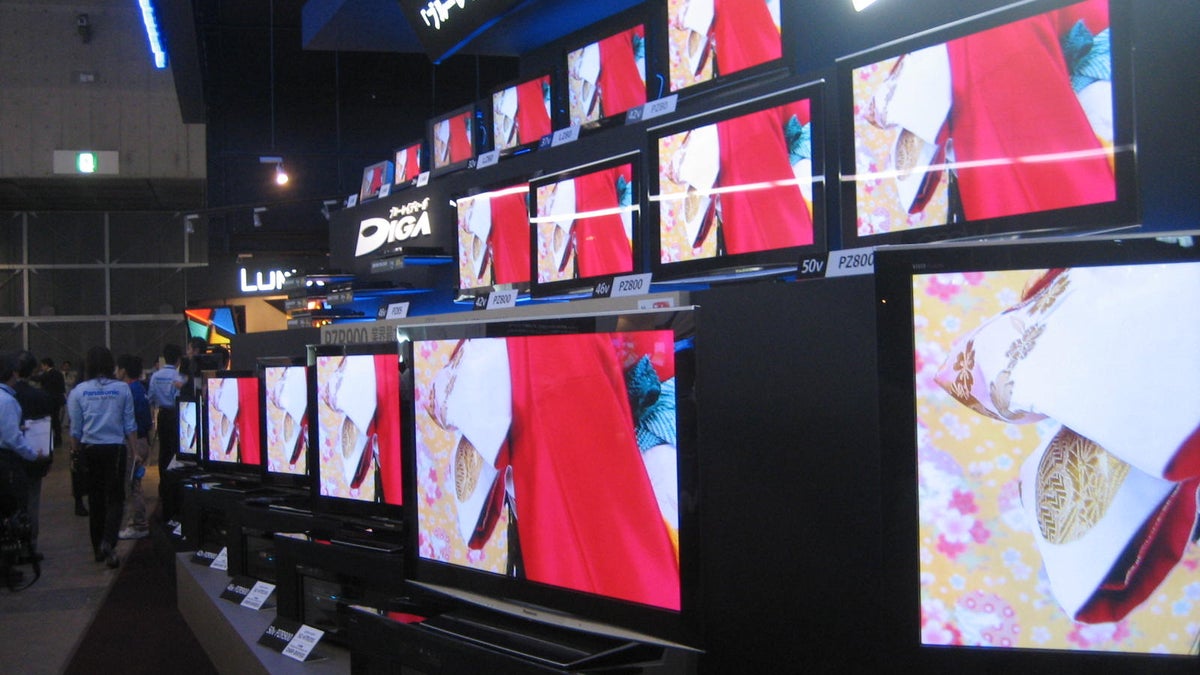Why some Ceatec gadgets get lost in translation
The annual Japanese gadget fest, kicking off Tuesday, is a hotbed of cutting-edge tech. But look while you can--not all of it makes it stateside.

Impossibly thin televisions, wireless HD video systems for the living room, and TVs that respond to gestures instead of a remote control were all things seen first at Ceatec, the annual gadget extravaganza outside Tokyo.
The show's well-earned reputation as a peek into our gadget future remains intact as Ceatec 2010 kicks off Tuesday. It's guaranteed to be full of some of the geekiest stuff you've ever seen, along with some fantastically designed gadgets, and a mostly realistic look into what the rest of the world will some day be buying for their homes, backpacks, and cars. Oh, and there will be plenty of creepy robots too.
The annual Japanese gizmo gathering will inevitably lead many Americans watching coverage from afar to ask, yet again: Why can't we get this stuff here?
Turns out, there's a reason. Actually, a few reasons. You will, in fact, see some of this stuff in the United States at January's Consumer Electronics Show in Las Vegas, so hang tight. But some of it--like fuel cells for portable televisions, Blu-ray recorders, and robots that take care of elderly family members--won't ever come to America. It's either too expensive, runs into legal issues, or doesn't have a widespread market outside Japan.
Japan--as anyone who saw "Lost in Translation" or any Japanese cartoon of, oh, the last two decades or so may know--has a unique love affair with its gadgetry.
The country's advanced public transportation system and extremely well-developed broadband and wireless networks mean that people living in Japan are, in general, far more comfortable with technologies and ideas that are just now nudging into the mainstream in the U.S.--using a cell phone to pay train fare or buy food is not a new concept there, nor is watching TV on a mobile device.
The country has also been home to an energy-efficiency and solar industry since the 1970s, and Nissan and Honda have been leading the electric vehicle charge. So the elaborate displays of smart grid-based neighborhoods and whole cities taken over by electric cars are closer to reality in Japan than in other places.
For decades, companies that call Japan home, like Sony, Sharp, Panasonic, Mitsubishi, and Nikon, produced some of the most cutting-edge TVs, home video products, cameras, and music gadgets--as well as marketing campaigns.
And though their influence in portable devices has been somewhat usurped by foreign companies like Apple and the Taiwan-based HTC and Korea-based Samsung, those companies still regularly turn out some of the most advanced technologies in the display and camera industries.
As a result, some of the stuff on display at Ceatec is eminently useful, and some of it is completely wacky, and may never actually make it to other consumer markets.
Tablets, robots, 3D TVs, and more
But that doesn't go for everything. There are plenty of accessible, mainstream gadgets on display. Sharp, for example, is likely to show off its newly announced tablet for the first time. Tablets are everywhere right now, and Japanese manufacturers are not going to be left behind.
The same goes for TVs. 3D TVs have been a staple of trade shows for a little over a year. And major TV makers (with the exception of Samsung and LG, Korean companies that do not attend the Japanese show) will show their latest concepts of 3D TVs and other display technologies.
One thing that Ceatec has been showing since at least 2008 is glasses-free 3D. This year there should be much more of this since the technology has no doubt advanced from the small cell phone displays and digital signs of earlier shows.
"You will probably see some glasses-less 3D, and hopefully somebody will do it well," said Auri Rahimzadeh, an analyst with T.A.G. who attends Ceatec every year. He says he hopes manufacturers at the show have caught on to the ill-suited nature of expensive glasses for watching 3D movies at home--especially when many 3D movies released on Blu-ray are aimed at younger audiences. "Anyone who has kids knows you don't want to need $70 glasses around children."
Then, of course, there's the significant aspect of the show that just will not translate to the U.S., or anywhere. That goes for the trade show's appeal itself (hall upon hall dedicated to the tiniest of components manufacturers, expensive cell phones that look like pieces of fine art, booth babes dressed like princesses from outer space, the amazing assortment of robots).
The robot selection is enormous: robots that sing and teach you to play piano, robots that care for the elderly and play with children, robots that ride bicycles, and plenty more. As prototypes go, they're impressive, and they're advancing robotics research, but as far as useful household gadgets are concerned--Roombas and Scoobas these are not.
One of the most practical aspects of Ceatec is the show's growing emphasis on green technologies. Nissan is hosting a 3D interactive theater in the exhibit hall that will show, in the style of virtual reality, a future vision of a "smart" city--a city that's connected to a smart grid and almost completely does away with carbon emissions.
Nissan is also constructing a one-third scale "solar forest." Each "tree" uses transmissive color solar panels and features an underground recyclable reserve cell that recharges electric vehicles. Besides electric cars, there will be electric bikes, and energy sipping chips and batteries. Components, as always at Ceatec, will be a large presence.
CNET will be covering Ceatec all next week. We'll try to bring you the coolest new green tech as well as the giant walls of TVs, robots galore, and more, so be sure to check back throughout the week.

